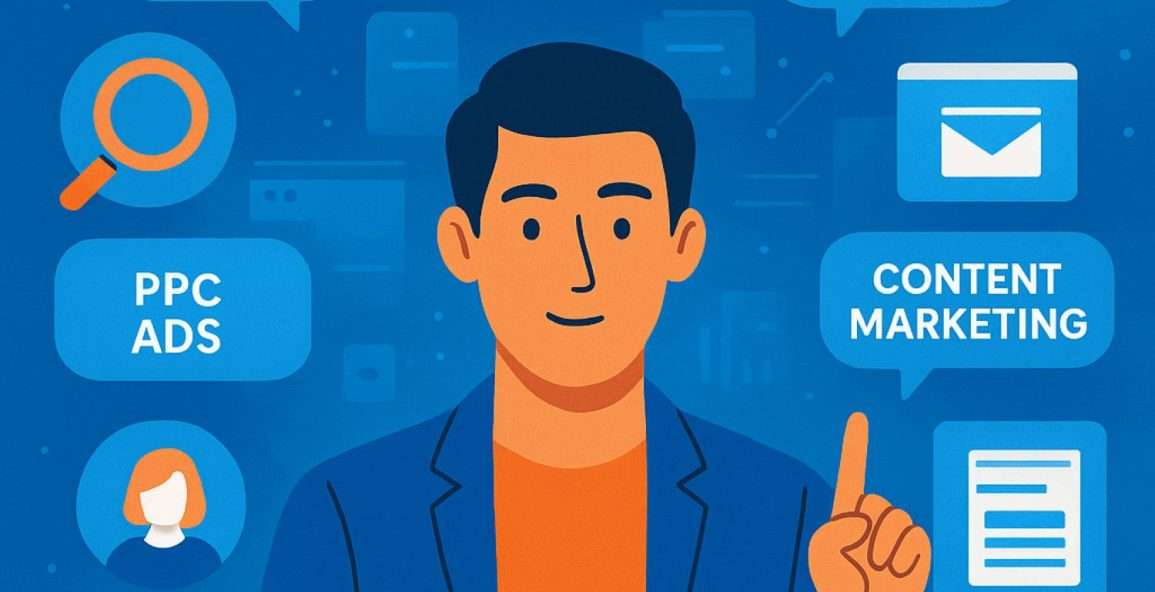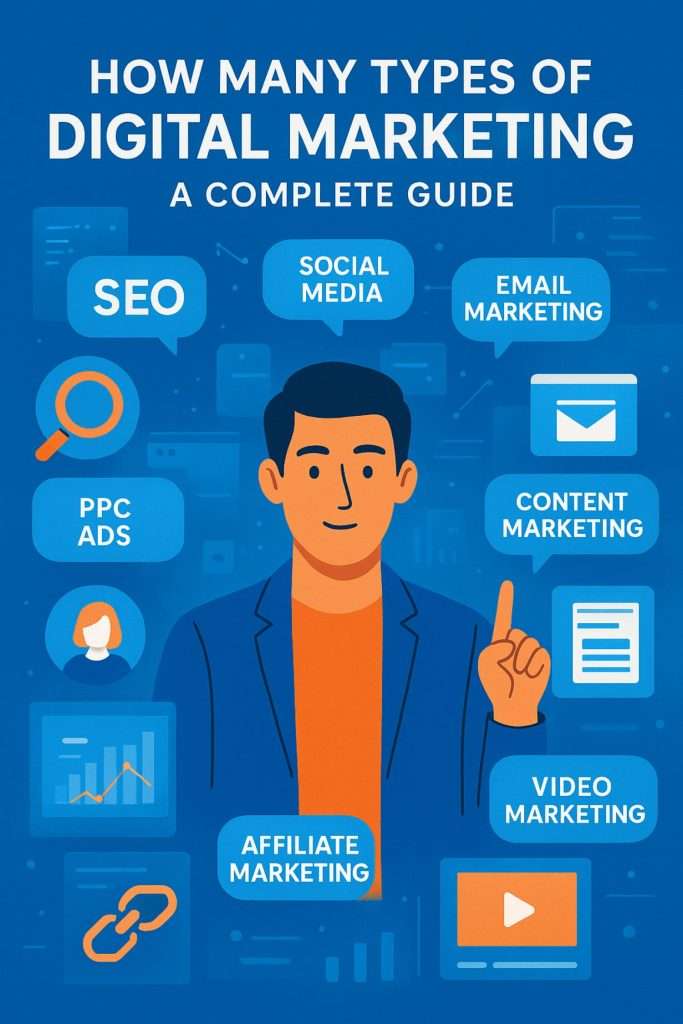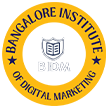
Digital marketing has transformed the way businesses reach their audience in the modern era. Traditional marketing methods are no longer sufficient to engage customers effectively, and digital marketing provides the tools and techniques to connect with people online. But many wonder, how many types of digital marketing exist? The answer is that digital marketing is a broad field with several branches, each serving a unique purpose and audience. Understanding these types is crucial for businesses, marketers, and anyone interested in the online business ecosystem.
In this guide, we will explore the most prominent types of digital marketing, their benefits, applications, and strategies to use them effectively. By the end of this article, you will have a comprehensive understanding of the digital marketing landscape.
Table of Contents
What is Digital Marketing?
Digital marketing refers to promoting products, services, or brands using digital channels. Unlike traditional marketing, it leverages the internet, social media, search engines, email, and other digital platforms to reach potential customers. It focuses on creating meaningful connections with the target audience and providing measurable results.

The growth of digital marketing has been fueled by the increasing use of smartphones, social media platforms, and search engines. Businesses of all sizes are adopting digital marketing to reach global audiences, improve brand visibility, and generate leads.
The Importance of Digital Marketing
Digital marketing is no longer optional for businesses; it is essential. Here’s why it matters:
- It allows businesses to reach a global audience without geographical constraints.
- Marketing campaigns can be tracked and measured in real-time.
- It is cost-effective compared to traditional advertising channels.
- It provides personalized marketing experiences.
- It strengthens brand awareness and credibility online.
The evolution of consumer behavior, where people spend more time online, has made digital marketing a vital tool for businesses seeking growth and competitive advantage.
How Many Types of Digital Marketing Exist?
Digital marketing encompasses several types, each serving different purposes. While the exact number can vary depending on how broadly you define them, the main categories include search engine marketing, content marketing, social media marketing, email marketing, affiliate marketing, influencer marketing, video marketing, and more. Let’s explore each of these in detail.
Search Engine Optimization (SEO)
SEO is the practice of optimizing a website so that it ranks higher in search engine results pages (SERPs). The goal is to increase organic traffic and improve online visibility. SEO is one of the most cost-effective forms of digital marketing because it targets users actively searching for products or services.
Key Components of SEO
- On-page SEO: Focuses on optimizing content, meta tags, keywords, images, and internal links on a website.
- Off-page SEO: Involves activities outside the website, such as link building, social signals, and influencer outreach.
- Technical SEO: Includes website structure, mobile-friendliness, speed optimization, and crawlability.
Benefits of SEO
- Increases website traffic.
- Builds brand authority.
- Improves user experience.
- Provides long-term marketing results.
SEO Strategies
To succeed in SEO, businesses must research keywords, create high-quality content, and regularly optimize their website. Combining SEO with content marketing and link-building strategies can deliver outstanding results.
Search Engine Marketing (SEM)
Search Engine Marketing involves paid strategies to increase visibility on search engines. While SEO focuses on organic results, SEM primarily uses paid ads like Google Ads.
How SEM Works
SEM allows businesses to bid on keywords relevant to their products or services. When users search for these keywords, the ads appear at the top or bottom of search results. Advertisers pay for each click (PPC model), making it highly measurable.
Benefits of SEM
- Immediate visibility on search engines.
- Targeted audience reach.
- Flexible budget options.
- Performance tracking and analytics.
SEM is ideal for businesses looking for quick results and a measurable return on investment.
Content Marketing
Content marketing is the strategy of creating valuable, relevant, and consistent content to attract and engage a target audience. Unlike traditional ads, content marketing focuses on providing information that educates or entertains potential customers.
Types of Content Marketing
- Blog Posts: Informative articles that address audience queries.
- Ebooks and Whitepapers: In-depth resources for lead generation.
- Infographics: Visual content to simplify complex information.
- Case Studies: Demonstrates product effectiveness through real examples.
Benefits of Content Marketing
- Builds trust and credibility with the audience.
- Enhances SEO efforts.
- Supports lead generation and conversions.
- Encourages audience engagement and sharing.
Effective content marketing requires a deep understanding of the target audience, consistent content creation, and distribution across multiple channels.
Social Media Marketing
Social media marketing involves promoting products, services, or brands through platforms like Facebook, Instagram, LinkedIn, Twitter, and TikTok. It is one of the most interactive forms of digital marketing.
Social Media Strategies
- Organic Social Media: Posting content that attracts and engages followers without paid promotion.
- Paid Social Media: Using paid ads to reach a wider audience.
- Influencer Marketing: Collaborating with influencers to promote products or services.
- Social Listening: Monitoring conversations to understand audience needs.
Benefits of Social Media Marketing
- Enhances brand awareness.
- Encourages direct engagement with customers.
- Supports viral marketing campaigns.
- Drives website traffic and conversions.
Social media marketing requires creativity, consistency, and engagement to be effective.
Email Marketing
Email marketing involves sending personalized messages to a list of subscribers. It is a highly effective method for nurturing leads, building customer loyalty, and promoting products or services.
Types of Email Marketing
- Newsletter Emails: Regular updates with news, articles, or offers.
- Promotional Emails: Focused on specific product launches or sales.
- Transactional Emails: Automated messages triggered by user actions.
- Drip Campaigns: Series of automated emails designed to guide leads through the sales funnel.
Benefits of Email Marketing
- Cost-effective marketing channel.
- High ROI when campaigns are targeted correctly.
- Builds relationships with customers.
- Allows segmentation for personalized messaging.
Email Marketing Tips
- Maintain a clean email list.
- Personalize content based on user behavior.
- Use compelling subject lines.
- Track analytics to optimize performance.
Affiliate Marketing
Affiliate marketing is a performance-based marketing strategy where businesses reward partners (affiliates) for driving traffic or sales. Affiliates promote products or services through their platforms and earn a commission for every successful conversion.
How Affiliate Marketing Works
- Businesses create affiliate programs with commission structures.
- Affiliates promote products via blogs, websites, or social media.
- Sales or leads generated through affiliate links are tracked.
- Affiliates receive a commission for successful conversions.
Benefits of Affiliate Marketing
- Expands brand reach.
- Low-risk marketing strategy.
- Increases sales without upfront costs.
- Leverages influencer or partner networks.
Affiliate marketing is suitable for businesses looking to scale sales through partnerships and digital networks.
Influencer Marketing
Influencer marketing leverages individuals with a strong online presence to promote products or services. Influencers can significantly impact purchasing decisions because they have established trust with their audience.
Types of Influencers
- Mega Influencers: Millions of followers; ideal for brand awareness.
- Macro Influencers: Hundreds of thousands of followers; high engagement.
- Micro Influencers: 10k–100k followers; niche audience with high trust.
- Nano Influencers: 1k–10k followers; very personalized engagement.
Benefits of Influencer Marketing
- Builds credibility and trust quickly.
- Reaches a targeted audience effectively.
- Encourages user-generated content.
- Increases social media engagement.
Tips for Influencer Marketing
- Choose influencers aligned with brand values.
- Monitor performance metrics like engagement and conversion rates.
- Build long-term partnerships rather than one-time promotions.
Video Marketing
Video marketing uses videos to promote products, services, or brands. With the rise of YouTube, Instagram Reels, and TikTok, video content has become one of the most engaging forms of marketing.
Types of Video Marketing
- Explainer Videos: Explain how a product or service works.
- Tutorial Videos: Step-by-step guides to educate users.
- Live Videos: Real-time interaction with the audience.
- Testimonial Videos: Showcase customer experiences.
Benefits of Video Marketing
- Increases engagement and retention.
- Supports SEO and website traffic.
- Enhances social media reach.
- Boosts conversions and sales.
Video marketing requires creativity, storytelling skills, and understanding audience preferences.
Pay-Per-Click Advertising (PPC)
PPC is a paid advertising model where businesses pay each time a user clicks on their ad. It is commonly used on search engines, social media, and display networks.
Benefits of PPC
- Immediate visibility in search results.
- Targeted advertising based on demographics and interests.
- Highly measurable results.
- Flexible budget allocation.
PPC campaigns require keyword research, ad creation, and ongoing optimization to maximize ROI.
Mobile Marketing
Mobile marketing focuses on reaching customers through mobile devices via apps, SMS, push notifications, and mobile-friendly websites.
Benefits of Mobile Marketing
- Targets users on the go.
- Personalizes messages based on location and behavior.
- Enhances customer engagement.
- Supports multi-channel campaigns.
Mobile marketing is essential as smartphone usage continues to grow globally.
Online Public Relations
Digital PR involves managing online presence and reputation. It includes strategies like media outreach, influencer collaborations, and content promotion to gain coverage on websites, blogs, and news outlets.
Benefits of Digital PR
- Improves brand credibility.
- Generates backlinks for SEO.
- Reaches new audiences.
- Enhances overall online presence.
Digital PR complements SEO and content marketing for long-term visibility.
Podcast Marketing
Podcasts are audio programs distributed online. Businesses use podcasts to educate, entertain, and engage audiences, building a loyal following.
Benefits of Podcast Marketing
- Builds authority and trust.
- Targets niche audiences effectively.
- Encourages long-term engagement.
- Offers sponsorship and advertising opportunities.
Podcast marketing requires consistent content, engaging storytelling, and promotion across channels.
Display Advertising
Display advertising involves visual ads placed on websites, apps, or social media. These can include banners, images, videos, or interactive ads.
Benefits of Display Advertising
- Increases brand awareness.
- Targets specific demographics.
- Supports retargeting campaigns.
- Enhances visual engagement.
Display ads are often combined with other digital marketing strategies for maximum impact.
Affiliate Partnerships and Referral Marketing
Referral marketing encourages existing customers to refer new users. Affiliate partnerships can also enhance this strategy by leveraging networks for broader reach.
Benefits
- Low-cost customer acquisition.
- Builds trust through word-of-mouth.
- Encourages loyalty and repeat business.
- Amplifies marketing reach.
Referral programs often use incentives to motivate sharing and engagement.
Conclusion
Digital marketing is a multifaceted field with numerous types, each serving a unique purpose. From SEO and SEM to social media, content marketing, email marketing, video marketing, and influencer campaigns, businesses have many options to engage audiences and achieve their goals. Understanding how many types of digital marketing exist helps businesses craft a strategy tailored to their objectives, target audience, and budget.
In today’s digital world, leveraging multiple types of digital marketing in a cohesive strategy ensures better reach, higher engagement, and improved ROI. By staying updated with trends and best practices, businesses can thrive online and remain competitive in the ever-evolving digital landscape.



